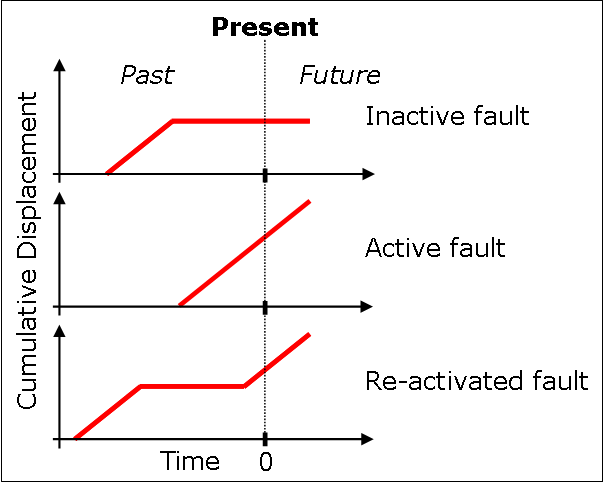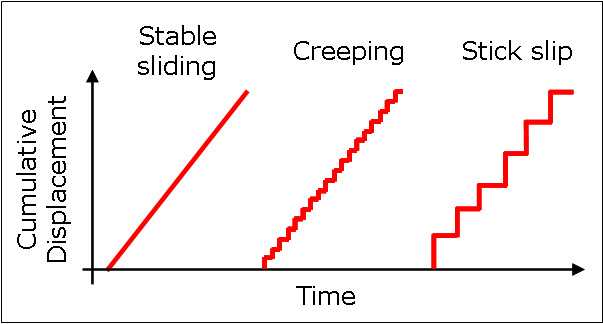Understanding Active Faulting
The activity of a fault is generally defined by the way it cumulates displacement over geologic time. An active fault has cumulated some displacement in the recent past (see diagrams below), so we can speculate it is very likely that the fault will be offset again in the future.
There is no fixed rule about what geological time scale is more appropriate to address the activity of a fault.
In addition to the time period of activity, active faults may exhibit different forms of behavior as shown by the diagram below or some combinations of them. The stick-slip behavior is usually associated with the active fault releasing several sizable earthquakes.
- Slemmons and McKinney (1977), quoting Wood (1916) and Willis (1923), suggest that an active fault has been offset during the present seismotectonic regime.
- Muir Wood and Mallard (1992) suggest that "no definition of an active fault can be satisfactory when founded on some extrinsic time-period." Preferably, it should be determined through "knowledge of fault-movement recurrence intervals, or ... from an understanding of the time period over which the present conditions of regional stress and strain have prevailed".
- Boschi et al. (1996) propose a "Consensus Statement" in which "An active fault of interest for Seismic Hazard Assessment is a structure that has an established record of activity in the Late Pleistocene (i.e., in the past 125 ka) and a demonstrable or inferable capability of generating major earthquakes.".
- In the Basin and Range Province, the WSSPC - Western States Seismic Policy Council (1997) defines three classes of active faults.
- Holocene active fault: a fault that has moved in the last 10,000 years.
- Late Quaternary active fault: a fault that has moved in the last 130,000 years.
- Quaternary active fault: a fault that has moved in the last 1,600,000 years.
- The NRC (1997) defines a tectonic structure of interest for seismic hazard when it produces "deformation of landforms or geologic deposits of a recurring nature within the last approximately 500,000 years or at least once in the last approximately 50,000 years" or when it is "characterized by its involvement in the current tectonic regime (the Quaternary, or approximately the last 2 million years)".
- Machette (2000) specifies that fault maps to be useful in seismic hazard analysis "should encompass a time interval that includes several earthquake cycles" and, for example, if "recurrence in an area is 20,000-50,000 years, then maps should include faults that are 50,000-100,000 years old". In the vicinity of plate boundaries map of faults younger than 10,000 years should include those with at least two to as many as twenty paleoearthquakes.
- The IAEA (2010) guidelines distinguish between active structures in different tectonic settings by proposing to consider an Upper Pleistocene-Holocene time frame in interplate regions and a Pliocene-Quaternary time frame in intraplate regions.
In addition to the time period of activity, active faults may exhibit different forms of behavior as shown by the diagram below or some combinations of them. The stick-slip behavior is usually associated with the active fault releasing several sizable earthquakes.
References
Boschi, E., D. Giardini, D. Pantosti, G. Valensise, R. Arrowsmith, P. Basham, R. Bürgmann, A.J. Crone, A. Hull, R.K. McGuire, D. Schwartz, K. Sieh, S.N. Ward and R.S. Yeats (1996). New trends in active faulting studies for seismic hazard assessment. Annali di Geofisica, XXXIX, 1301-1307.
IAEA (2010), Seismic hazards in site evaluation for nuclear installations, Safety Standards Series No. SSG-9, p. 60, https://www.iaea.org/resources/safety-standards.
Machette M.N. (2000), Active, capable, and potentially active faults - a paleoseismic perspective, Journal of Geodynamics, 29, 387-392.
Muir Wood R. and D.J. Mallard (1992), When is a fault "extinct"?, Journal of Geological Society of London, 149, 251-255.
NRC (U.S. Nuclear Regulatory Commission) (1997). Regulatory Guide 1.165. Identification and characterization of seismic sources and determination of safe shutdown earthquake ground motion, U.S. Nuclear Regulatory Commission, Office of Nuclear Regulatory Research, March 1997.
Slemmons D.B. and R. McKinney (1977), Definition of "Active Fault", U.S. Army Engineer Waterways Experiment Station Soil and Pavements Laboratory, Miscellaneous paper S-77-8, Final Report, May 1997, p. 22.
Willis B. (1923), A fault map of California, BSSA, 13, 1-12.
Wood H.O. (1916), The earthquake problem in the western United States, BSSA, 6, 181-217.
WSSPC (Western States Seismic Policy Council) (1997), Active fault definition for the Basin and Range Province. WSSPC Policy Recommendation 97-1 White Paper, May 22, 1997, San Francisco, CA, p.3.
Boschi, E., D. Giardini, D. Pantosti, G. Valensise, R. Arrowsmith, P. Basham, R. Bürgmann, A.J. Crone, A. Hull, R.K. McGuire, D. Schwartz, K. Sieh, S.N. Ward and R.S. Yeats (1996). New trends in active faulting studies for seismic hazard assessment. Annali di Geofisica, XXXIX, 1301-1307.
IAEA (2010), Seismic hazards in site evaluation for nuclear installations, Safety Standards Series No. SSG-9, p. 60, https://www.iaea.org/resources/safety-standards.
Machette M.N. (2000), Active, capable, and potentially active faults - a paleoseismic perspective, Journal of Geodynamics, 29, 387-392.
Muir Wood R. and D.J. Mallard (1992), When is a fault "extinct"?, Journal of Geological Society of London, 149, 251-255.
NRC (U.S. Nuclear Regulatory Commission) (1997). Regulatory Guide 1.165. Identification and characterization of seismic sources and determination of safe shutdown earthquake ground motion, U.S. Nuclear Regulatory Commission, Office of Nuclear Regulatory Research, March 1997.
Slemmons D.B. and R. McKinney (1977), Definition of "Active Fault", U.S. Army Engineer Waterways Experiment Station Soil and Pavements Laboratory, Miscellaneous paper S-77-8, Final Report, May 1997, p. 22.
Willis B. (1923), A fault map of California, BSSA, 13, 1-12.
Wood H.O. (1916), The earthquake problem in the western United States, BSSA, 6, 181-217.
WSSPC (Western States Seismic Policy Council) (1997), Active fault definition for the Basin and Range Province. WSSPC Policy Recommendation 97-1 White Paper, May 22, 1997, San Francisco, CA, p.3.







